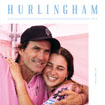A history of the Gold Cup at Cowdray
By Victoria Elsbury-Legg
Played annual in July on the pitches at Cowdray, it is easy to see why patrons and professionals alike take so much pride and pleasure in competing for the honour of winning the Gold Cup. Even a patron preoccupied with his business in another distant country or city cannot help but unwind en route to the ground at Cowdray, as the quintessential beauty of the English countryside filled with the scent of summer drifts through their car windows and takes them back to a less hectic bygone era.
On arrival at the Lawns there is a feeling of history and a tradition in the air, hardly surprising when you consider Midhurst began to develop as a village in 1066 and in 1284 Sir John Bohun moved from Ford to make his new home at Coudreye, now the site of the Cowdray ruins. This is an estate used to upheaval and visits. In 1588 and the defeat of the Spanish Armada, the first Viscount was placed under house arrest at Cowdray because of his Catholicism, a few years later in August 1591 Queen Elizabeth I, who most certainly would have enjoyed the subsequent battles played out on the polo pitches, made a visit to the Estate.
With the first ball that was supposedly stuck on English soil being hit across Hounslow Heath in 1869 in a match organised by Captain Edward ‘Chicken’ Hartopp from the British Cavalry 10th Hussars, in later years it was John, 3rd Viscount of Cowdray and his friends who were responsible for ensuring the survival of polo in a post war England, that seemed to have little use for the game in a rapidly modernising world.
In January 1930, in the passionate style evoked by Polo, four unknown, dashing players called the Ashton Brothers sailed from Australia to compete in the English Polo season with their friend Lord Cowdray. Bringing with them 26 home bred ponies they embarked upon an epic three month sea voyage across 13,300 miles to play against the best players from England, American and India.
Rather unsurprisingly, with English Polo at its lowest ebb during this period, their adventures captured the imagination of the British Press, who stated even before they had left Australian shores, they would never complete the trip and set foot or hoof on British soil. With the ponies stabled in specially installed loose boxes, ridden around the ship’s deck and trained and exercised daily in a small round sand yard on deck, the players and ponies not only defied the odds and arrived in England, but within two weeks they had won their first game.
The imminent onset of the looming war did not prevent the brothers returning to England in 1937 and the influence of these entrepreneurial brothers in English Polo is still very much in evidence today. In the devastating post World War II years, when English Polo almost disappeared into extinction, it was to his friend Bob Ashton that Lord Cowdray turned to help the British Polo Association re-establish the game, and it is in recognition of his support, that even to this day, the winner of the subsidiary final of the Cowdray Park Gold Cup holds aloft The Ashton Cup.
The Gold Cup itself began in 1956, a few years before the Queen’s Cup which was first presented in 1960. Often referred to as the ‘British Open’, it was first won 9-4 by Los Indios, a team comprising of Argentine farmer Antonio Heguy and three of his friends who were invited by Lord Cowdray to play in the inaugural tournament and subsequently beat the home side.
Since this first year of the competition, played and won on a boatload of home bred ponies, many things have changed significantly. Embryo breeding, sponsorship by Veuve Clicquot since 1995, official timekeeping by Jaeger-LeCoultre, and teams and players funded by patrons from many different countries and backgrounds have all added further richness to this most significant tournament and its highly acclaimed place on the high goal polo fixtures list. Indeed, in its setting amidst Viscount Cowdray’s 16,500 acre estate, where the game has been played since 1910, there are many who would say that outside of Argentina, this is the most important of polo tournaments.
If you cast a glance down past tournament team lists or study the surnames forever engraved in the plaques around the much converted square base on which the Gold Cup sits, there cannot be many greats not included. Alongside the Heguys, Hipwoods, Gracidas, Donosos, Novillo Astradas, Tomlinsons, MacDonoughs and Pieres, there are of course also the patrons who have played, many too from polo families. HRH, The Prince of Wales, the Vestey’s, the Beresfords, the Hanburys, and Kerry and Jamie Packer (whose triple win owed much to the breeding and bloodlines which still continue to add beauty and horsepower to the sport) and in recent years, Lyndon Lea and Zacara (winners in 2011 & 2013) whose skill and teamwork have dominated the sport.
The one name remaining to add to that list, which is never far from anyone’s lips when discussing high goal, is the current number one player in the world – Adolfo Cambiaso. It was with Antony Embirico’s team Tramontana and David Jamison in the 1980’s, that a still teenage Cambiaso discovered English polo, ironically playing for a team whose five Gold Cup wins mean they still hold the record for the most successful team ever to have played in the tournament.
Cowdray Park Polo Club is a place where gentleman and ladies have gathered for years to watch some of the most spectacular polo outside of Argentina unfold, against a backdrop of fields full of buttercups and the buzz of bees in the air, whilst sipping champagne and eating afternoon tea. The tranquillity of the surroundings may now be occasionally punctuated by the whir of a helicopter descending, or departing with a triumphant patron, but even this cannot silence the whispers from the tumbling stones of the ruins, where the spirits of past players gather with the Knights from even more distant times to observe the battles unfold on the pitches at Cowdray.
So as the players and teams alike eagerly await the play on Sunday, it just remains to be seen whether it will Dubai who walk away with their fourth win, or if it is newcomers to the tournament King Power who will triumphantly head home with the Veuve Clicquot Gold Cup .


